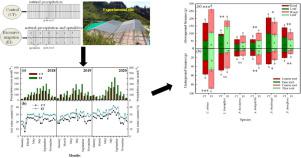Agricultural and Forest Meteorology ( IF 5.6 ) Pub Date : 2022-06-28 , DOI: 10.1016/j.agrformet.2022.109071 Narayan Bhusal , Arjun Adhikari , Minsu Lee , Areum Han , Ah Reum Han , Hyun Seok Kim

|
In the era of extreme weather events, plant resistance to excessive water should be considered for plantations in frequently flooded areas to ensure their maximum survival and conservation of natural habitats. Therefore, we quantified the resistance to excessive irrigation (REI) in seedlings of six conifer species on the basis of their morphological, physiological, and biochemical traits. Two different irrigation regimes, natural precipitation as a control treatment and additional irrigation by sprinklers (30.89 ± 2.80% above natural precipitation) as excessive irrigation, were applied for three consecutive years. The changes in the morphological, physiological, and biochemical traits under long-term excessive irrigation were species-specific. There were three distinct responses in biomass accumulation: drought-susceptible Chamaecyparis obtusa and Abies holophylla significantly increased their aboveground and underground biomass and showed a strong REI; Pinus thunbergii and P. densiflora, both resistant to drought, significantly decreased their aboveground and underground biomass and showed a weak REI. Larix kaempferi and Pinus koraiensis showed a medium REI with only aboveground biomass increment in the former and no biomass change in the latter. Plant biomass responses corresponded well with the changes in morphological, physiological, and biochemical traits. Biomass augmentation resulted from an increase in leaf size, leaf mass per area (LMA), maximum photosynthesis rate, and leaf water potential. Flavonoids, LMA, and stomatal conductance are the most important traits to assess species REI. This study elucidates plant responses to excess water and traits that drive their tolerance. The findings will help in the selection of species for flood-tolerant afforestation programs and establishment of sustainable forests in regions with increased frequency and severity of excessive rainfall.
中文翻译:

6种裸子植物在长期过度灌溉条件下的生长响应评价及决定物种抗涝性的性状
在极端天气事件的时代,在经常被洪水淹没的地区,种植园应考虑植物对过量水分的抵抗,以确保其最大程度地生存和保护自然栖息地。因此,我们量化了对过度灌溉的抵抗力(R EI) 在六种针叶树种的幼苗中,根据它们的形态、生理和生化特征。连续三年采用两种不同的灌溉方式,即作为对照处理的自然降水和作为过度灌溉的喷头额外灌溉(高于自然降水的 30.89 ± 2.80%)。长期过度灌溉下形态、生理和生化性状的变化具有物种特异性。生物量积累有三种不同的反应:干旱敏感的日本扁柏和万叶冷杉显着增加了它们的地上和地下生物量,并表现出强烈的R EI;红松和P. densiflora均抗旱,其地上和地下生物量显着降低,R EI较弱。落叶松和红松表现出中等的R EI,前者仅增加地上生物量,后者无生物量变化。植物生物量响应与形态、生理和生化性状的变化很好地对应。生物量增加是由于叶片大小、每面积叶质量 (LMA)、最大光合作用速率和叶片水势的增加。类黄酮、LMA 和气孔导度是评估物种R EI的最重要特征. 这项研究阐明了植物对过量水分的反应以及驱动其耐受性的特征。这些发现将有助于选择用于抗洪造林计划的物种,并在过度降雨频率和严重程度增加的地区建立可持续森林。











































 京公网安备 11010802027423号
京公网安备 11010802027423号